Do you have libraries in SharePoint that you need to monitor for additions and perhaps even changes? I know that if you are checking these libraries manually, that over time, you will occasionally forget especially if you are as busy as I am. One way to receive notifications automatically is by setting up alerts within SharePoint. Alerts are a great tool that can send you an email when the contents of a library or list has been updated. You even have options that determine what types of changes you want to be notified about. Alerts can be scheduled to arrive instantly, daily, or monthly. With daily alerts, you can even specify when during the day you want to receive the notice and for weekly alerts you can specify not only the time, but also the day of the week.
With all that flexibility, what could RSS feeds possibly offer that alerts do not? One thing that RSS feeds provide is a description of each object in the feed which provides a better idea of its contents than simply receiving an alert containing the title of the object. RSS feeds can also be managed by any RSS reader of which you probably have at least two on your desktop. First you have Outlook which also receives the alert emails. However, rather than go into your traditional email box, Outlook places RSS feeds in a separate folder in the Folders section rather than the Mail section. RSS feeds can also be opened by other applications including stand-alone RSS readers and most modern browsers such as IE. Most RSS readers also let you organize your RSS feeds by their source which may not be easy or even possible with alerts coming into your email’s inbox folder.
So how would I go about adding an RSS feed from a SharePoint site?
First I have to make sure that RSS has been enabled for my site. My SharePoint administrator or I can do this by going to Site Settings of the site from which I want to create the feed and within the Site Administration group of options, click RSS.
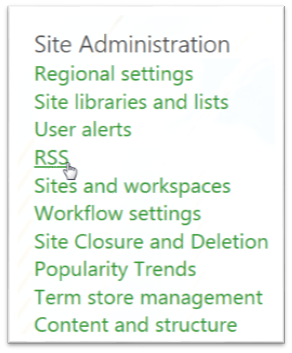
The RSS options appear in the following figure and include the capability of adding a copyright notice, editor and webmaster names and a frequency of pushing out updates. By default, SharePoint recommends sending out RSS updates only once every hour (60 minutes). However, the most important property is the check box at the top of this figure that allows me to enable and disable RSS feeds for the current site.

Next I would open the library or list from which I want to receive the feed. Let’s assume for this article that I am creating a RSS feed from a library (the steps are similar to those for a SharePoint list). From the Library ribbon as shown in the following figure, find and click the RSS Feed option in the Share & Track group.
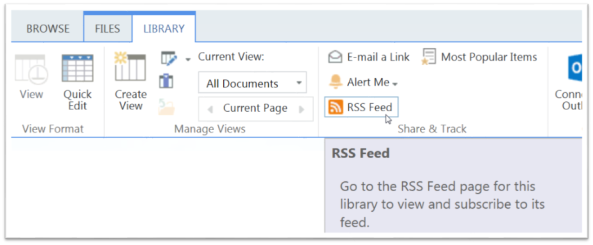
A page appears with some basic information about what an RSS Feed is and includes a link to subscribe to this feed. While the text refers to a generic RSS reader, the default is usually your email application such as Microsoft word.

Because the server application (SharePoint) is trying to open and use a program on my computer (Outlook) a dialog appears as part of the security features of the operating system asking if I really want to allow the website to open that program. This action is normal and should be allowed as long as I know and trust the URL that is trying to make the connection.

After opening Outlook, Sharepoint tries to add the RSS Feed to Outlook. Again, security within Outlook requires permission for another program to add a subscription within Outlook.
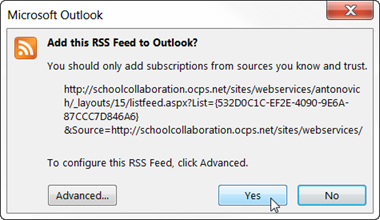
While there are some advanced options when creating a RSS feed to Outlook, most of the time, I can safely ignore these options and just click the Yes button as shown in the above image. However, for future reference, you may want to know just what those advanced options are just in case you might need them. So the following figure shows the advanced options.

The feed name is generally a concatenation of the site name and the library or list name with a colon separating the two. I can change the text the user sees by changing the Feed Name in this dialog. Note that this has no effect on the feed source. I also see a location reference. Notice that the location URL contains a GUID to uniquely identify the library or list. If I delete and recreate the source library or list, the new version gets a new GUID. Therefore, any RSS Feeds pointing to the old location will fail and the location URL must be regenerated.
It is also possible to change the folder in which Outlook saves the RSS feed.
The next two check boxes let me determine whether the RSS Feed automatically downloads any enclosures, otherwise known as attachments, from the library or list. This allows me to open the attachments even if I do not have an active internet connection to SharePoint. In addition, I can ask Outlook to download the full article as an .HTML attachment so that I can read the article without having to be connected to the Internet to get to my SharePoint server. This feature can be especially useful when using an RSS feed to an intranet site so that I can read the feeds outside of the office without using a VPN connection.
Finally, by default, Outlook only queries the RSS feed source once every hour. Therefore notification of additions or changes do not occur immediately, but do occur within at most 60 minutes.
After clicking OK, Outlook creates the RSS Feed in the Folders section of Outlook as shown in the image below.

When I click on the folder representing my feed, the center section of Outlook displays the items in the feed much like the Mail section of Outlook displays individual emails. To read an article from the feed, I double click on it. I can also easily delete an article from your Outlook feed. Note that deleting the article from my local feed does not delete the source article in SharePoint so I can feel free to get rid of the articles I have already read.

In addition to displaying the feed in Outlook, I can have the feed appear in both Outlook and IE using what is called the Common Feed list. I can get to this setting from Outlook’s properties. On the File submenu and select Options as shown in the following image.
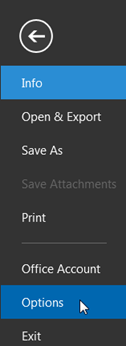
From the Outlook Options dialog, I click the Advanced group of option in the left navigation. Then in the right panel, I scroll down to the RSS Feeds section. Click check box before the option: Synchronize RSS Feeds to the Common Feed List (CFL) in Windows. I may also want to check the option to redisplay as new any RSS feed item that has been modified.
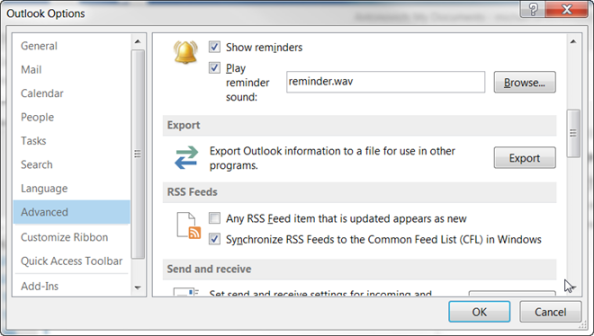
After saving my property changes in Outlook, all RSS feeds that I subscribe to in the future will appear in both Outlook and IE under the Feeds tab of the View Favorites dropdown. To open a feed, I click on the feed name. Note, adding feeds to the CFL will not affect existing feeds already in Outlook.
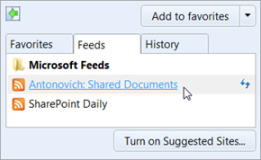
That’s all for today. C’ya next time.